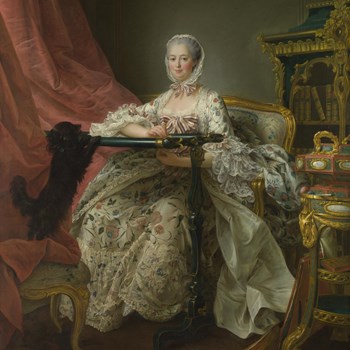This week, Ms Carr-Gomm discusses Francois-Hubert Drouais’ ‘Madame de Pompadour at her Tambour Frame’.
“I have always loved this friendly painting and greatly admired this woman and now I think of how she would have continued to smile through these long, drawn-out lockdown days.
Mme de Pompadour sits rather upright, busy at her embroidery frame which holds the cloth tight for her to stitch; no idle hands here. She is pampered and seems older than her 42 years because of her fashionably powdered grey hair but she looks out at the spectator with an animated welcome. She wears a pretty floral dress with delicate lace trim and a pink bow; she looks upholstered like the gilded furniture of her private apartments in Versailles and, in her comfortable surroundings, she would like to invite us to join her and her playful companion and entertain us with intelligent and amusing conversation.
She was accomplished in many ways: she apparently sung with all gaiety and good taste imaginable and she took part in plays. The lute on the floor with its pink strap refers to her musical talents. She was known as the Godmother of Rococo, leading a feminine taste in painting and the decorative arts; she was a great patron of artists, dress designers and the Sevres porcelain factory and their distinctive pink is called after her, rose Pompadour; you can see this on the worktable beside her.
In this portrait there is an ornate cabinet of books presenting Mme de Pompadour as a femme savante. The books refer to the great encyclopaedic work of the Enlightenment, undertaken by Denis Didero and others, to gather together all known knowledge; how they would be overawed by a single go on google! She apparently read extensively and corresponded with Voltaire and I am sure she would have joined our book club.
Thanks to her pretty features and lively wit she became King Louis XVs mistress aged 23, a position she held for several years. Even when the King found pleasure in other women and her detractors were many, her influence was felt in all aspects of royal policy and she remained comfortable and rich until her death in 1764. She was an international celebrity and an extremely influential figure in court circles in an age when power was a male preserve. She must have been a very clever woman!”














